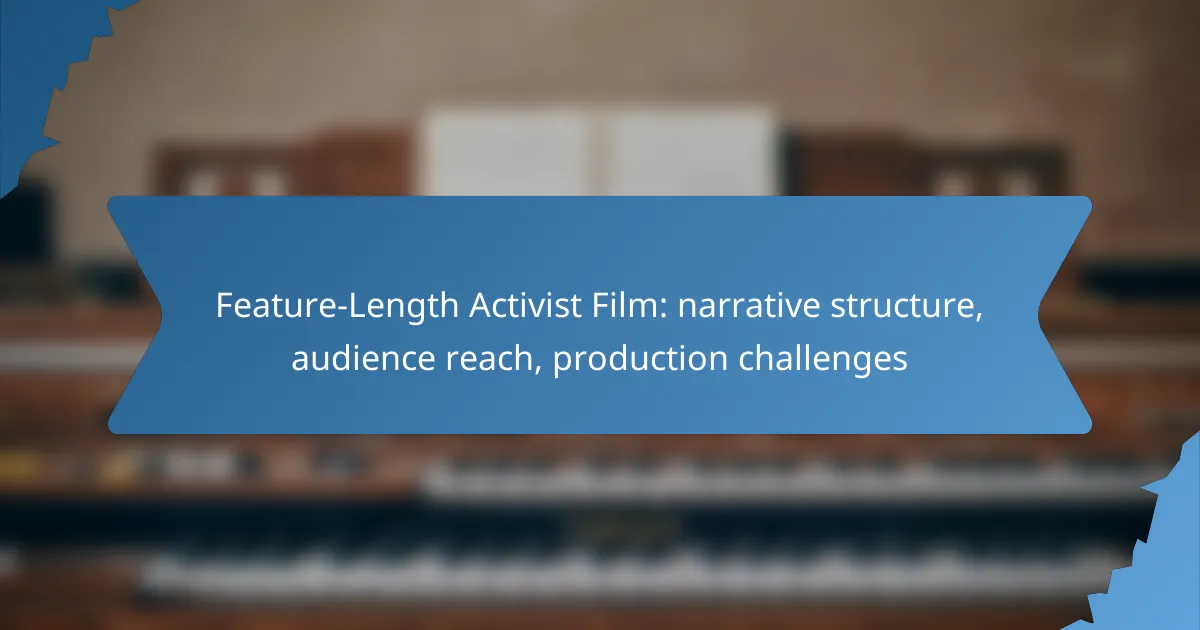Feature-length activist films play a crucial role in raising awareness and driving social change by employing compelling narrative structures that engage audiences emotionally and intellectually. In the UK, filmmakers can enhance their reach through strategic use of social media, community screenings, and partnerships with NGOs. However, they often face significant production challenges, including funding constraints and legal hurdles, which can hinder the realization of their impactful projects.

How can feature-length activist films effectively reach audiences in the UK?
Feature-length activist films can effectively reach audiences in the UK by leveraging various platforms and community engagement strategies. By utilizing social media, hosting community screenings, collaborating with NGOs, participating in film festivals, and creating educational partnerships, filmmakers can maximize their impact and audience reach.
Utilizing social media platforms
Social media platforms are essential for promoting feature-length activist films. Filmmakers should create engaging content, such as trailers, behind-the-scenes footage, and interviews, to attract viewers. Platforms like Twitter, Instagram, and Facebook allow for targeted advertising, enabling filmmakers to reach specific demographics interested in activism.
Regular updates and interactive posts can foster a community around the film, encouraging audience participation and sharing. Hashtags related to the film’s themes can also enhance visibility and engagement.
Engaging with community screenings
Community screenings provide a direct way to connect with local audiences. Organizing events in venues like community centers, schools, or local cinemas can create a shared experience that resonates with viewers. These screenings often encourage discussions and feedback, deepening the film’s impact.
Filmmakers should consider partnering with local organizations to promote these events, ensuring that the screenings reach those who are most likely to be affected by the issues presented in the film.
Collaborating with NGOs
Collaboration with non-governmental organizations (NGOs) can enhance the reach of activist films. NGOs often have established networks and audiences that align with the film’s message. By partnering with these organizations, filmmakers can tap into their resources for promotion and outreach.
Joint campaigns or events can be organized, where the film serves as a tool for advocacy, raising awareness about specific causes and mobilizing audiences for action.
Leveraging film festivals
Film festivals are a powerful platform for showcasing feature-length activist films. They provide opportunities for exposure to industry professionals, critics, and potential distributors. Filmmakers should submit their films to relevant festivals that focus on social issues or activism to gain visibility.
Participating in Q&A sessions or panel discussions at these festivals can further engage audiences and provide context for the film’s themes, enhancing viewer understanding and interest.
Creating educational partnerships
Establishing partnerships with educational institutions can broaden the reach of activist films. Schools and universities can incorporate these films into their curricula, facilitating discussions around the issues presented. This approach not only educates students but also encourages critical thinking and activism.
Filmmakers can offer resources such as discussion guides or workshops to accompany the film, enhancing its educational value and encouraging deeper engagement with the subject matter.
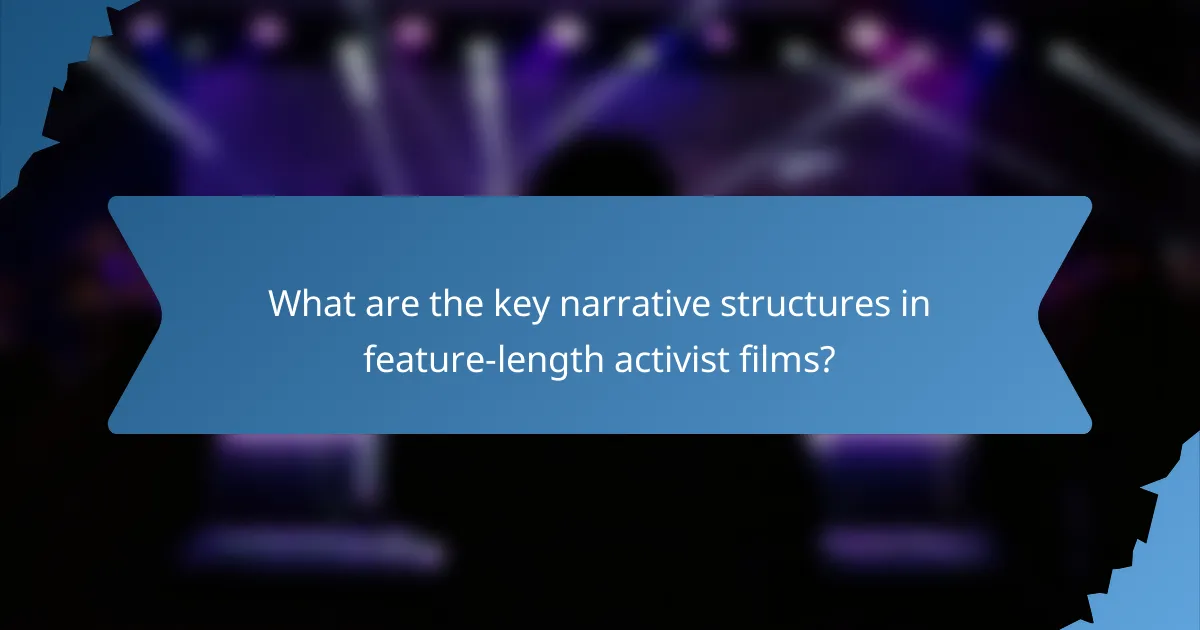
What are the key narrative structures in feature-length activist films?
Key narrative structures in feature-length activist films often revolve around character-driven storytelling and issue-based narratives. These structures help convey the film’s message effectively while engaging the audience emotionally and intellectually.
Character-driven storytelling
Character-driven storytelling focuses on the personal journeys of individuals affected by social issues. By highlighting their struggles, triumphs, and transformations, filmmakers create a relatable connection with the audience.
This approach often involves in-depth character development, allowing viewers to empathize with the protagonists. For instance, a film might follow a single mother fighting against environmental degradation, illustrating her challenges and resilience.
Issue-based narratives
Issue-based narratives center around specific social, political, or environmental topics, aiming to raise awareness and provoke thought. These films often present facts, statistics, and expert opinions to support their message.
For example, a documentary on climate change may showcase the scientific consensus while featuring activists advocating for policy changes. This structure can effectively mobilize audiences to take action on pressing issues.
Documentary vs. dramatized formats
Documentary formats typically present real-life events and interviews, providing an authentic perspective on the issues at hand. They often rely on factual storytelling to educate viewers and inspire change.
In contrast, dramatized formats use actors and scripted narratives to convey the same messages, allowing for creative interpretation. While both formats can be impactful, documentaries may appeal more to audiences seeking factual information, whereas dramatized films can engage viewers through emotional storytelling.
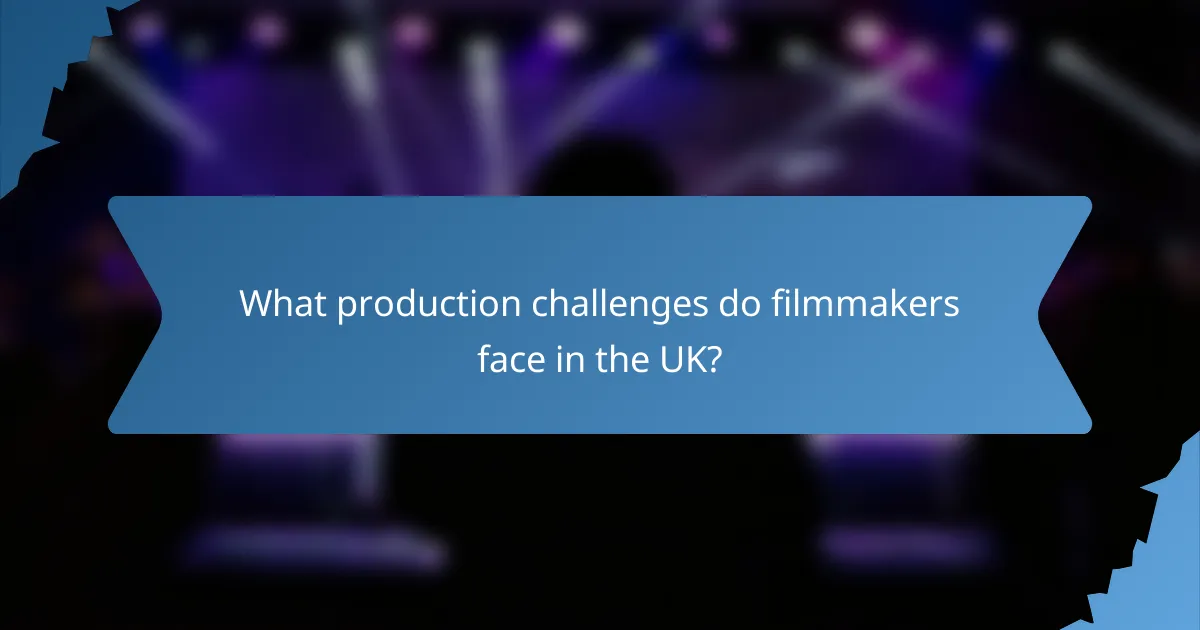
What production challenges do filmmakers face in the UK?
Filmmakers in the UK encounter various production challenges that can significantly impact their projects. These include securing funding, accessing necessary resources, and navigating legal regulations.
Funding and budget constraints
Securing funding is often the most significant challenge for UK filmmakers. Many projects rely on a mix of public funding, private investment, and crowdfunding, which can be unpredictable. Budgets can vary widely, but independent films often operate within the low tens of thousands to several million pounds.
Filmmakers should prepare detailed budgets and funding proposals to attract investors. It’s crucial to clearly outline potential returns and audience engagement strategies to increase the likelihood of securing financial support.
Access to resources and equipment
Accessing high-quality resources and equipment can be a hurdle for filmmakers in the UK, particularly for independent projects. Rental costs for cameras, lighting, and sound equipment can be substantial, often consuming a significant portion of the budget.
Filmmakers can mitigate these costs by collaborating with local film schools or community organizations that may offer equipment rentals at reduced rates. Networking within the industry can also lead to shared resources and partnerships that enhance production capabilities.
Legal and regulatory hurdles
Navigating legal and regulatory hurdles is essential for filmmakers in the UK. This includes obtaining necessary permits for filming, adhering to copyright laws, and ensuring compliance with health and safety regulations. Failure to address these issues can lead to costly delays or legal disputes.
Filmmakers should familiarize themselves with the UK Film Classification and Licensing regulations. Engaging a legal expert early in the process can help identify potential issues and streamline compliance, allowing for a smoother production experience.
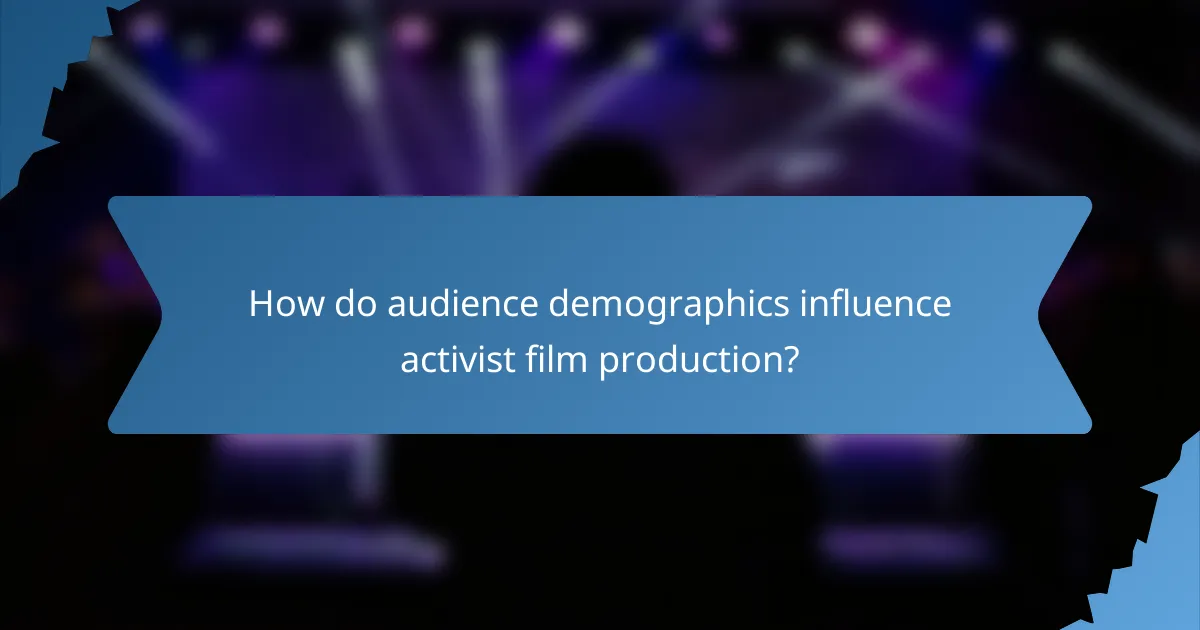
How do audience demographics influence activist film production?
Audience demographics significantly shape the production of activist films by determining content focus, marketing strategies, and distribution channels. Understanding the age, cultural background, and interests of the target audience helps filmmakers create resonant narratives that engage viewers effectively.
Targeting specific age groups
When targeting specific age groups, filmmakers must consider the values and preferences that resonate with different generations. For instance, younger audiences may prefer dynamic storytelling and social media integration, while older viewers might appreciate more traditional narratives and in-depth analysis.
To effectively reach these demographics, filmmakers can utilize platforms popular among their target age groups. For example, using TikTok or Instagram for younger audiences can enhance engagement, while Facebook or documentary screenings may be more effective for older viewers.
Catering to cultural backgrounds
Catering to diverse cultural backgrounds is essential for creating inclusive activist films that reflect various perspectives. Filmmakers should research cultural norms, values, and issues relevant to their audience to ensure authenticity and relatability in their narratives.
In practice, this may involve collaborating with cultural consultants or incorporating multilingual elements. For example, a film addressing environmental issues in a specific community might include local dialects and highlight culturally significant practices to foster a deeper connection with the audience.
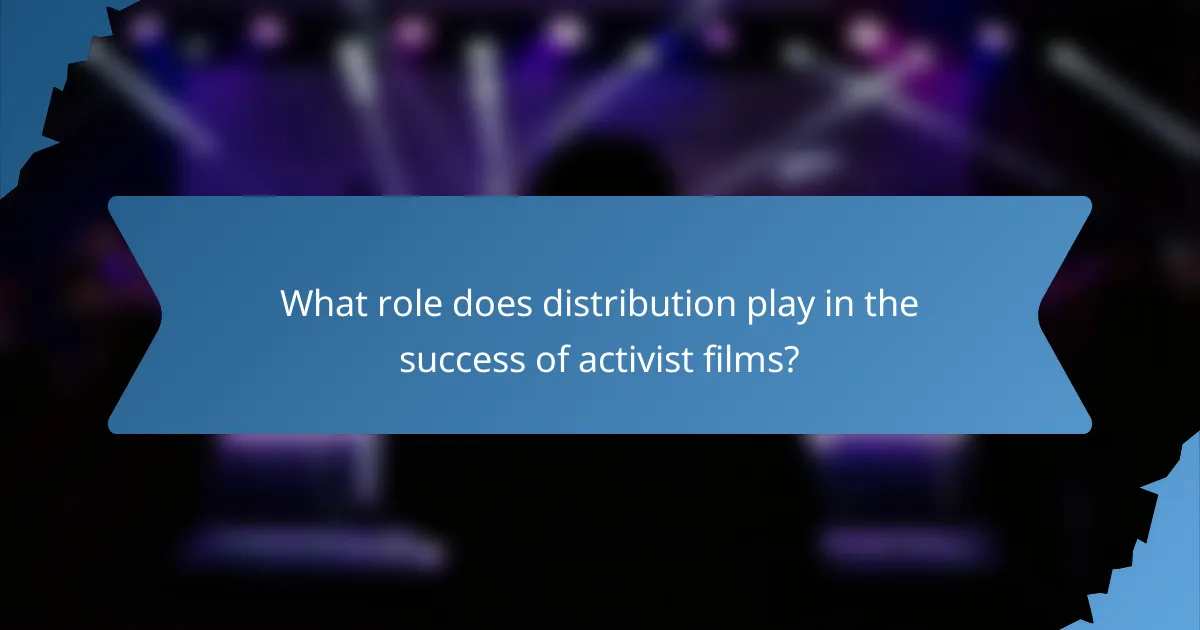
What role does distribution play in the success of activist films?
Distribution is crucial for the success of activist films as it determines how widely the film reaches its intended audience. Effective distribution strategies can amplify the film’s message, engage viewers, and drive social change.
Online streaming platforms
Online streaming platforms have become a primary distribution channel for activist films, allowing filmmakers to reach global audiences quickly and cost-effectively. Services like Netflix, Amazon Prime, and Hulu provide a vast audience base, often leading to higher visibility and engagement.
Filmmakers should consider the platform’s audience demographics and content guidelines to ensure alignment with their film’s message. Additionally, leveraging social media to promote the film on these platforms can enhance viewer engagement and discussion.
Traditional cinema releases
Traditional cinema releases can provide a powerful way to showcase activist films, offering a communal viewing experience that can foster discussion and reflection. However, securing theater space can be challenging, often requiring partnerships with independent cinemas or film festivals.
Filmmakers should aim for targeted marketing campaigns that resonate with local communities, potentially collaborating with local organizations to boost attendance. Limited theatrical runs can also create buzz and lead to increased interest in subsequent distribution formats.
DVD and Blu-ray sales
DVD and Blu-ray sales remain relevant for activist films, especially for collectors and educational institutions. These physical formats can include bonus content, such as director’s commentary and behind-the-scenes footage, which can enhance the viewer’s understanding of the film’s message.
Filmmakers should consider bundling these sales with educational materials or community screenings to maximize impact. Additionally, setting a reasonable price point can encourage purchases while supporting grassroots movements and initiatives related to the film’s subject matter.
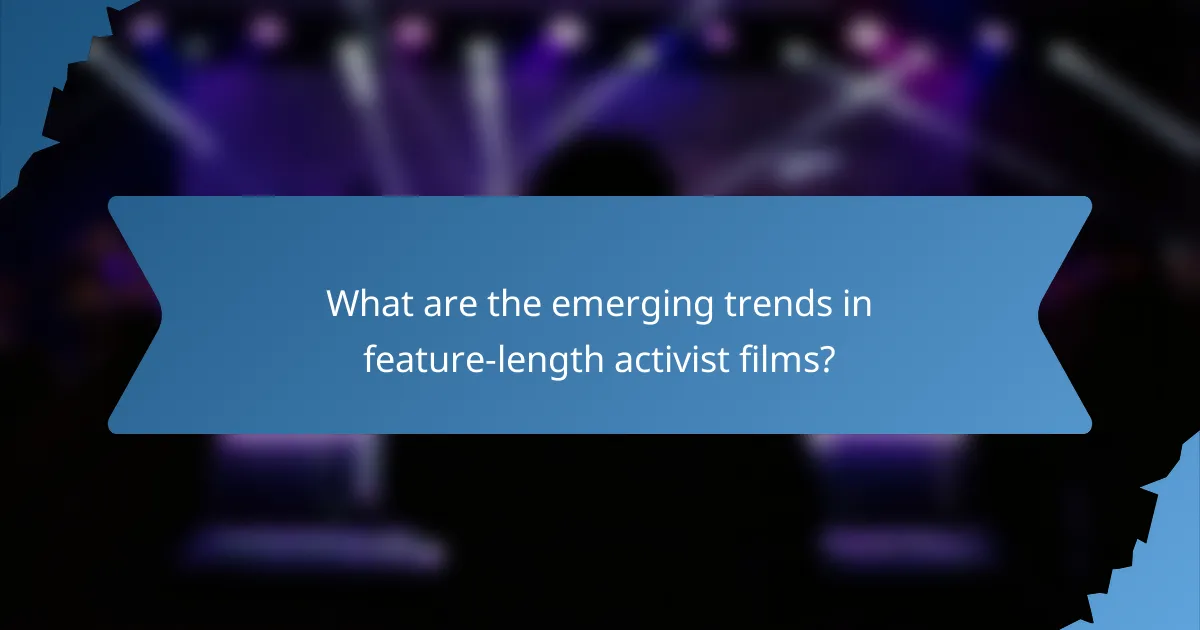
What are the emerging trends in feature-length activist films?
Emerging trends in feature-length activist films include innovative storytelling techniques and the integration of technology to enhance audience engagement. Filmmakers are increasingly exploring new formats and platforms to reach diverse audiences and amplify their messages.
Increased use of virtual reality
Virtual reality (VR) is becoming a significant tool in feature-length activist films, allowing viewers to immerse themselves in the subject matter. This technology creates a powerful emotional connection by placing audiences directly in the environment or situation being depicted.
Filmmakers can use VR to simulate experiences related to social issues, such as climate change or human rights violations, making the content more impactful. For instance, a VR film might allow viewers to walk through a deforested area, highlighting the urgency of environmental activism.
When considering VR for activist films, it’s essential to balance production costs with potential audience reach. While VR can enhance engagement, the technology requires specialized equipment and expertise, which may not be accessible for all filmmakers.
